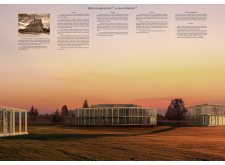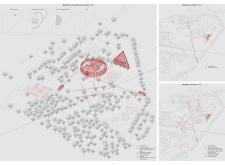5 key facts about this project
At its core, the project represents a commitment to minimalism and utility, delivering spaces that adapt to both community interactions and environmental conditions. The architecture is envisioned as a living entity, capable of evolving over time through a phased development approach. This strategic planning allows for flexibility, enabling the project to respond to user needs and feedback throughout its life cycle.
The functional aspects of the project are designed to cultivate community engagement and facilitate social interactions. Central to its design is a variety of communal areas that foster connection, while private spaces remain accessible. This balance between public and private use reflects a deep understanding of human behavior and promotes a sense of belonging among occupants. The careful spatial arrangement enhances usability, making each zone distinctly purposeful without overwhelming users.
One of the noteworthy features of the project is its unique design approach to material selection. The architecture utilizes structural steel, glass, wood, and copper, each chosen for its environmental impact and performance characteristics. Structural steel provides strength and longevity, while extensive glazing allows natural light to permeate interior spaces, effectively blurring the boundaries between the indoor environment and the external landscape. The use of wood adds warmth and texture, creating inviting interiors, whereas copper elements not only contribute to aesthetics but also offer practical benefits, such as natural antimicrobial properties.
Sustainability is a fundamental aspect of the project, reflected in both its design principles and operational strategies. Passive heating and cooling methods are integrated into the architectural framework, minimizing energy consumption. The incorporation of green roofs and vertical gardens enriches the ecosystem, enhancing biodiversity and improving air quality. This mindful approach creates an environment that respects natural resources and reinforces the importance of sustainable practices within architectural design.
The design also prioritizes clarity and transparency. The extensive use of glass throughout the façades invites views of the surrounding landscape, promoting an ongoing connection with nature. This transparency extends to the project's internal organization, where strategic placements of windows and open-plan layouts enhance visibility and create a sense of openness that benefits user experience.
As the project transitions through its phased development, each stage reveals a deeper engagement with the site and its users. The architectural plans outline a cohesive layout that balances functionality with aesthetics. Detailed architectural sections exhibit the thoughtful relationship between different spaces, enhancing circulation and access. The interplay of light within these areas is key to establishing an inviting atmosphere that encourages interaction.
The architectural designs focus not only on the visible structures but also on the surrounding landscape, integrating natural features that harmonize with the built environment. The project challenges conventional architectural ideas by prioritizing quality over quantity, encouraging a slower, more considered approach to construction and usage.
In summary, "Minimum Viable Product as Slow Architecture" is a significant architectural project that demonstrates effective design strategies while adhering to sustainable practices. Its embodiment of adaptability, community focus, and environmental mindfulness showcases a viable model for future developments. Readers are encouraged to explore the architectural plans, sections, and further details within the project presentation to gain a comprehensive understanding of its design and intent. This exploration may provide valuable insights into how architecture can serve as a catalyst for community engagement and environmental sustainability.


























